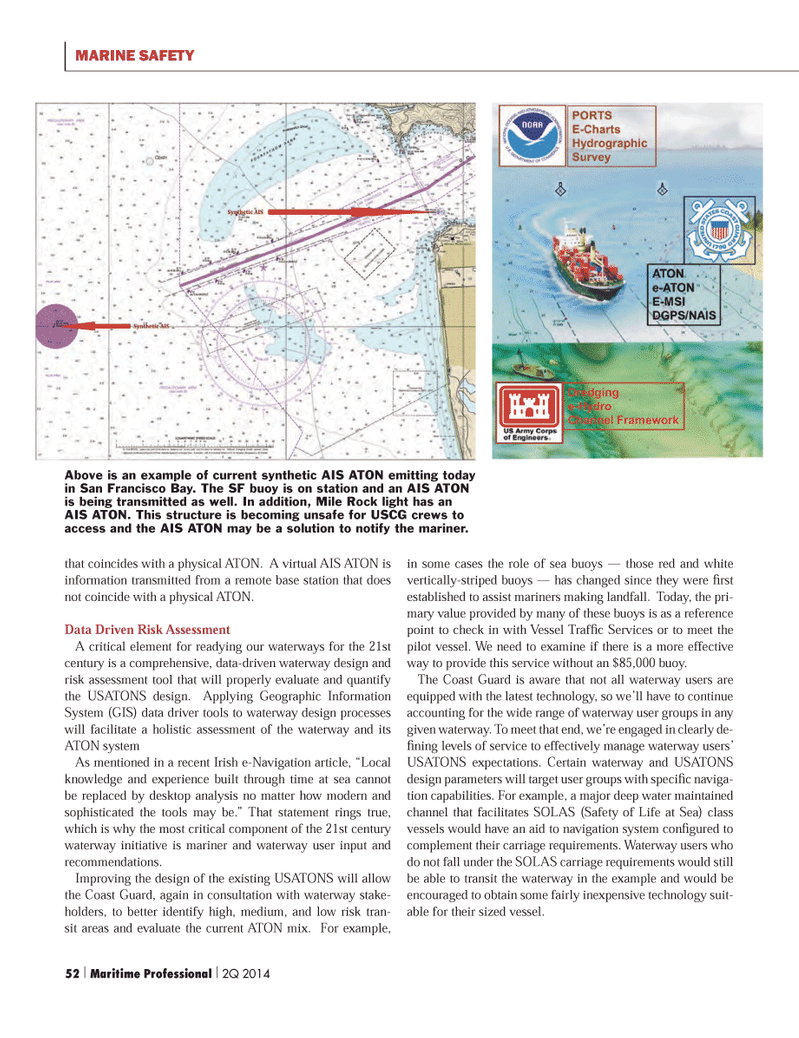
Page 52: of Maritime Logistics Professional Magazine (Q2 2014)
Maritime Risk & Shipping Finance
Read this page in Pdf, Flash or Html5 edition of Q2 2014 Maritime Logistics Professional Magazine
that coincides with a physical ATON. A virtual AIS ATON is information transmitted from a remote base station that does not coincide with a physical ATON.
Data Driven Risk Assessment
A critical element for readying our waterways for the 21st century is a comprehensive, data-driven waterway design and risk assessment tool that will properly evaluate and quantify the USATONS design. Applying Geographic Information
System (GIS) data driver tools to waterway design processes will facilitate a holistic assessment of the waterway and its
ATON system
As mentioned in a recent Irish e-Navigation article, “Local knowledge and experience built through time at sea cannot be replaced by desktop analysis no matter how modern and sophisticated the tools may be.” That statement rings true, which is why the most critical component of the 21st century waterway initiative is mariner and waterway user input and recommendations.
Improving the design of the existing USATONS will allow the Coast Guard, again in consultation with waterway stake- holders, to better identify high, medium, and low risk tran- sit areas and evaluate the current ATON mix. For example, in some cases the role of sea buoys — those red and white vertically-striped buoys — has changed since they were fi rst established to assist mariners making landfall. Today, the pri- mary value provided by many of these buoys is as a reference point to check in with Vessel Traffi c Services or to meet the pilot vessel. We need to examine if there is a more effective way to provide this service without an $85,000 buoy.
The Coast Guard is aware that not all waterway users are equipped with the latest technology, so we’ll have to continue accounting for the wide range of waterway user groups in any given waterway. To meet that end, we’re engaged in clearly de- fi ning levels of service to effectively manage waterway users’
USATONS expectations. Certain waterway and USATONS design parameters will target user groups with specifi c naviga- tion capabilities. For example, a major deep water maintained channel that facilitates SOLAS (Safety of Life at Sea) class vessels would have an aid to navigation system confi gured to complement their carriage requirements. Waterway users who do not fall under the SOLAS carriage requirements would still be able to transit the waterway in the example and would be encouraged to obtain some fairly inexpensive technology suit- able for their sized vessel.
MARINE SAFETY
Above is an example of current synthetic AIS ATON emitting today in San Francisco Bay. The SF buoy is on station and an AIS ATON is being transmitted as well. In addition, Mile Rock light has an
AIS ATON. This structure is becoming unsafe for USCG crews to access and the AIS ATON may be a solution to notify the mariner. 52 | Maritime Professional | 2Q 2014 50-63 Q2 MP2014.indd 52 5/16/2014 2:59:45 PM

 51
51

 53
53
